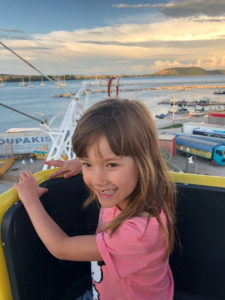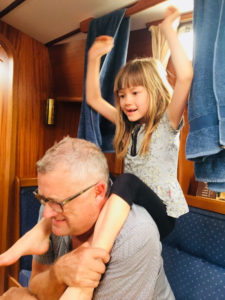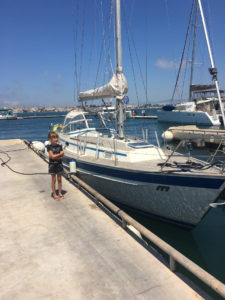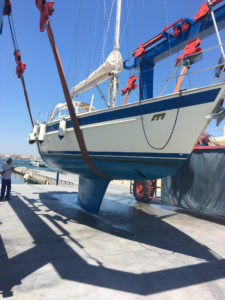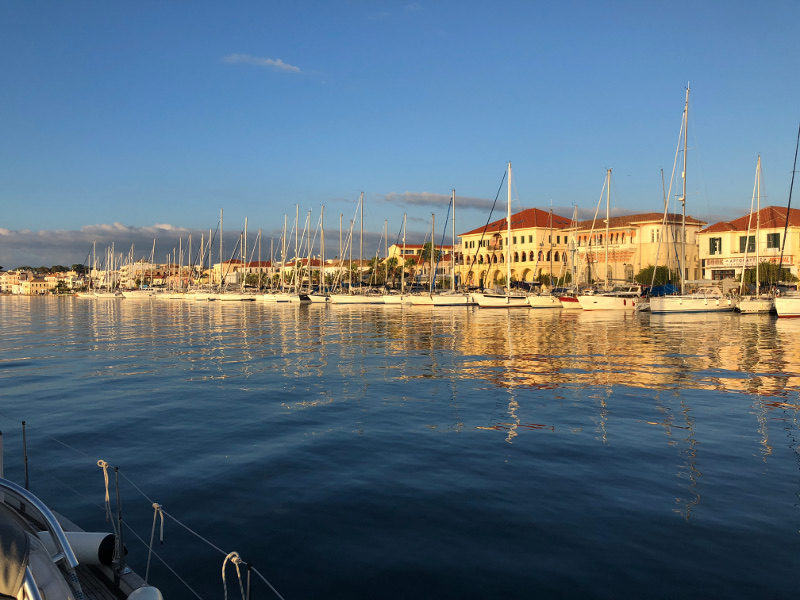
After three years in the Mediterranean we make Ronja ready for Mediterranean sailing
38° 57′ 27.7884” N 20° 45′ 26.4132” E
July 12th
“If it’s a difficult harbour? It is the most difficult in the whole of the Mediterranean,”declares the port assistant who helps us into Cleopatra Marina. “We have measured currents of up to 11 knots,” he adds. It sounds crazy, but he has worked in several ports, so he lets us understand that he knows, what he is talking about.
It is the Cleopatra Marina’s location in the strait, that leads from the open sea and into the big bay, Amvrakikos Kolpos, which makes the port seem difficult to maneuver. Winds and currents become more concentrated as they pass the narrow strait with the city of Préveza on one side and the peninsula Aktion on the other side.
For us, it does not matter. We are here just to get Ronja lifted on land at the end of this year’s sailing. Here she will stay for nine months, until April 2019, on a large, dusty car park for pleasure boats. It seems to us that hundreds or even a thousand boats are parked here on each of their stands, while waiting for their owner to afford or having time to put them back into the water.
We have decided, that Ronja shall have extra service and have completed some enhancements while she is on land at Cleopatra Marina. She has been underway from Denmark for six years, she has sailed in the Mediterranean for three years, and now now what is needed make her a real Mediterranean sailing boat.
Ronja was built in Sweden, built to keep away hard and cold weather, to anchor at relatively shallow water, to create warmth inside rather than coolness and to sail in waters with lower content of salt than the Mediterranean. In the Mediterranean, it’s about keeping the heat away, being open to any cool breeze, and to anchor frequently and in relatively deep water.
- Granddauhter Nellie likes to sail. But Prevezas funpark is better
- WM in football is watched on the computer
We therefore meet Cleopatra Marina with a pretty long wish list, that we want the yard to give us a quotation for. The main points are:
We need a longer anchor chain. In the Mediterranean, our 40 meter chain is simply not enough. We must have it extended to at least 60 meter chain. At the same time, we need to strengthen our secondary anchor system, the stern anchor, which currently has only three meters of chain plus ten meters of rope. It is not even near, what is needed in the Mediterranean. We must have at least six meters of chain and 20 meters rope for the stern anchor.
In addition, we sometimes feel, that we are the only ones in the whole of the Mediterranean, who are still throwing anchor and, not least, pulling it up by hand. Everyone else leans comfortably to the forestay while they – with a remote control in the hand – lower and raise their anchor by electricity. Come on. I’ve just reached 66. Kirsten is 64. We want that such an electric windlass as well.
And then there is the cockpit tent and sprayhood. Also here is the current build to keep wind, rain and cold away, but in the Mediterranean we need openness, plenty of fresh air, open sides, shade – even while we’re sailing – and high ceilings. So we ask for the price of a brand new set up with a so-called bimimi as the focal point. And when we are in the process, we ask for the price of a solar panel on top of the bimimi, because in Denmark anchoring was one thing we did occasionally and only for one night, anchoring in the Mediterranean is something we do several times week and would love to do for more than one night. This requires energy to keep on the fridge, pumps and reading lights, and this can be provided by the sun.
Further we would like to have a shower on the bathing platform. In Denmark it was okay to the take a bath in the bathroom, when we had taken a swim. But in the Mediterranean, the water is really salty, and salt puts traces all over the boat, unless you rinse it off in fresh water immediately. We have noticed that all southern European boats are equipped with a freshwater outlet near their bathing platform, so as a natural routine, they rinse off before getting into the cockpit and cabin. You must possible have tried it, in order to see the importance of this issue.
We also ask for offers to improve our electrical system. We would like a 220 volt outlet at the chartboard, we would like to have 12 volts charging of mobile phones and VHF radios and we would like to install two small 12 volt fans in the main cabin to ensure coolness even when we do not have access to land electricity.
Beside all this, we ask for a service on Ronja’s inboard engine, in particular the starting motor that, 20 years old, has begun to be unstable, and also the outboard engine, that has apparently dirt in the carburetor.
- Nellie watches for her first time Ronja beeing lifted to land
- Ronja on her way to nine months of hard-stand in Cleopatra Marina
